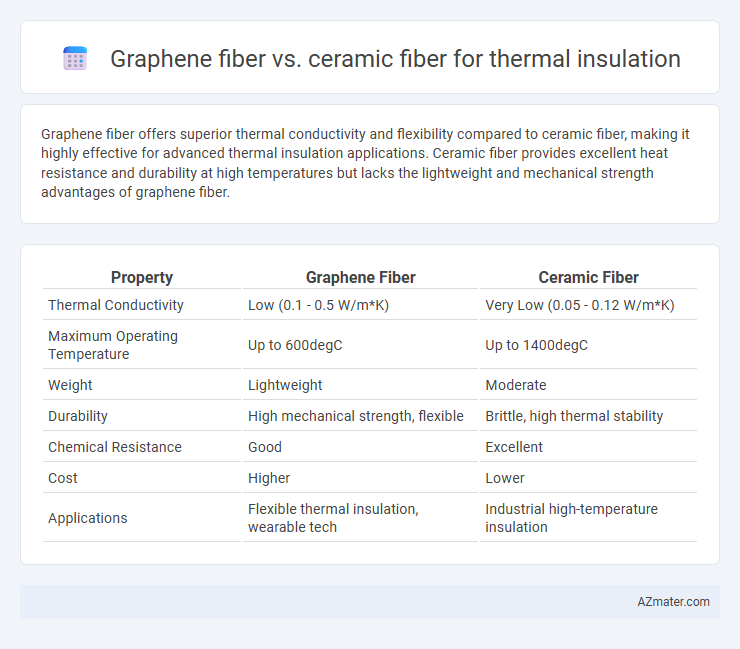Graphene fiber offers superior thermal conductivity and flexibility compared to ceramic fiber, making it highly effective for advanced thermal insulation applications. Ceramic fiber provides excellent heat resistance and durability at high temperatures but lacks the lightweight and mechanical strength advantages of graphene fiber.
Table of Comparison
| Property | Graphene Fiber | Ceramic Fiber |
|---|---|---|
| Thermal Conductivity | Low (0.1 - 0.5 W/m*K) | Very Low (0.05 - 0.12 W/m*K) |
| Maximum Operating Temperature | Up to 600degC | Up to 1400degC |
| Weight | Lightweight | Moderate |
| Durability | High mechanical strength, flexible | Brittle, high thermal stability |
| Chemical Resistance | Good | Excellent |
| Cost | Higher | Lower |
| Applications | Flexible thermal insulation, wearable tech | Industrial high-temperature insulation |
Introduction to Thermal Insulation Materials
Graphene fiber and ceramic fiber are advanced thermal insulation materials known for their exceptional heat resistance and low thermal conductivity. Graphene fiber offers superior mechanical strength, flexibility, and thermal conductivity properties, making it ideal for lightweight and high-performance insulation applications in aerospace and electronics. Ceramic fiber excels in withstanding extremely high temperatures, chemical stability, and excellent thermal shock resistance, commonly used in industrial furnaces, kilns, and fire protective gear.
What Are Graphene Fibers?
Graphene fibers are advanced thermal insulation materials composed of aligned graphene sheets, offering exceptional heat resistance and thermal conductivity compared to traditional fibers. Unlike ceramic fibers, which rely primarily on inorganic compounds like alumina and silica for high-temperature endurance, graphene fibers provide superior flexibility, mechanical strength, and reduced weight while maintaining efficient thermal insulation. These properties make graphene fibers highly suitable for aerospace, electronics, and industrial applications requiring lightweight, durable, and thermally stable materials.
Properties of Ceramic Fibers
Ceramic fibers exhibit exceptional thermal stability, withstanding temperatures up to 1,650degC, making them ideal for high-temperature insulation applications. They possess low thermal conductivity and excellent resistance to chemical corrosion and thermal shock, contributing to energy efficiency and durability in industrial furnaces and kilns. Unlike graphene fibers, ceramic fibers provide superior fire resistance and long-term structural integrity under extreme thermal stress.
Thermal Conductivity Comparison
Graphene fiber exhibits significantly lower thermal conductivity than ceramic fiber, making it superior for thermal insulation applications where minimal heat transfer is critical. While ceramic fibers have thermal conductivities ranging from 0.03 to 0.07 W/m*K, graphene fibers can achieve values as low as 0.001 to 0.01 W/m*K due to their unique atomic structure and high phonon scattering. This reduced thermal conductivity in graphene fiber leads to enhanced energy efficiency and improved thermal management in advanced insulation solutions.
Heat Resistance and Stability
Graphene fiber offers superior heat resistance up to 5000degC, maintaining structural integrity and thermal conductivity under extreme temperatures, making it ideal for high-performance thermal insulation. Ceramic fiber, typically stable up to 1260degC to 1425degC, excels in insulating applications at moderately high temperatures but degrades when exposed to prolonged extreme heat. The exceptional thermal stability and mechanical strength of graphene fiber provide a significant advantage over ceramic fiber in advanced thermal management systems.
Mechanical Strength and Flexibility
Graphene fiber exhibits superior mechanical strength and exceptional flexibility compared to ceramic fiber, making it ideal for applications requiring both durability and thermal insulation. Ceramic fiber, while providing excellent thermal resistance, tends to be brittle and less flexible, limiting its use in dynamic or flexible environments. The high tensile strength and elastic modulus of graphene fibers enhance structural integrity without compromising insulation performance.
Energy Efficiency Performance
Graphene fiber demonstrates superior thermal conductivity control compared to ceramic fiber, enabling enhanced energy efficiency in insulation applications due to its exceptional heat dissipation properties. Ceramic fiber offers high-temperature resistance but lacks the adaptive heat management seen in graphene, resulting in higher energy losses over prolonged use. Utilizing graphene fiber in thermal insulation can significantly reduce heating and cooling energy consumption, optimizing overall thermal performance.
Applications in Industry
Graphene fiber offers superior thermal conductivity and mechanical strength, making it ideal for high-performance industrial insulation in aerospace, electronics, and automotive sectors. Ceramic fiber excels in high-temperature resistance and chemical stability, widely used in furnaces, kilns, and power plants for thermal insulation and fireproofing. Industries prioritize graphene fiber for lightweight, flexible insulation solutions while ceramic fiber remains dominant in extreme thermal environments requiring durability and heat resistance.
Environmental Impact and Safety
Graphene fiber offers superior thermal insulation with a significantly lower environmental footprint due to its lightweight, durability, and recyclability compared to ceramic fiber, which is energy-intensive to produce and often non-recyclable. Graphene fiber is non-toxic and poses minimal health risks during handling, whereas ceramic fiber can release respirable fibers linked to potential respiratory hazards. Choosing graphene-based insulation reduces waste generation and enhances workplace safety, aligning with sustainable building practices.
Cost and Scalability Analysis
Graphene fiber offers superior thermal conductivity and durability but comes at a significantly higher production cost compared to ceramic fiber, which remains more economical for large-scale applications. Ceramic fiber benefits from established manufacturing processes allowing easy scalability and widespread availability, whereas graphene fiber production is limited by complex synthesis methods and higher material costs. Evaluating long-term cost-effectiveness depends on application-specific thermal performance needs, with ceramic fiber favored for budget-sensitive projects and graphene fiber suited for advanced insulation requirements despite current scalability challenges.

Infographic: Graphene fiber vs Ceramic fiber for Thermal insulation
 azmater.com
azmater.com